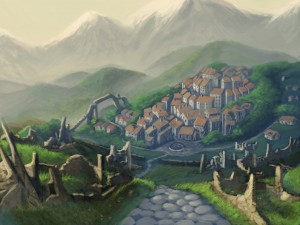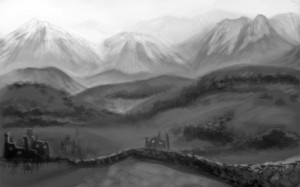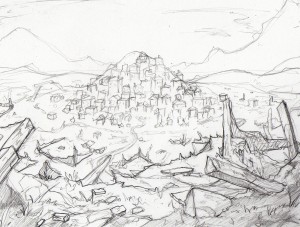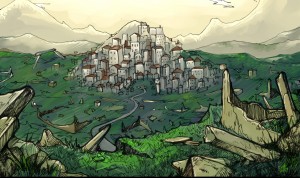Work on Blackwell has been going pretty well, but we’re just getting started. A ton of work goes into creating a graphic novel. I thought it would be fun to talk about what it took to create just a single panel.
When I first outlined the graphic novel, I knew setting our story in Blackwell would mean fleshing out more of the city. Right after Dan signed on to be our main artist, we had him make a couple of sketches of the city and its environment. Thinking of our story, we had to pay careful attention to the environment surrounding the city (mountains, a river) and also the layout of the city itself, which is sharply divided between the wealthy and the poor. Both of these elements would play major roles in shaping the story. Before we could move forward, we had to make sure everything was finalized. Afterwards, we shared Dan’s work with our graphic novel artists to get everyone on the same page.
- Dan’s Blackwell Concepts
As I outlined the story in greater detail and took a first stab at the script, it didn’t take long to determine our first panel would be an establishing shot of the city. It sounds simple enough, but even with a seemingly basic panel, there are always little details to work out. First, from what point of view would we see the city? From far away? Or just outside the city’s entrance? Second, we had to think about how whatever we came up with would transition to Hideo himself, who begins the story in the outskirts, captive to Sister Penelope’s goons. It didn’t take long to decide that showing the main city from the point of view of a person standing in the outskirts would work best. Following that, we could easily pan over to where Hideo is tied up.
Next, as with any panel, the text must be laid out. There are two types of text running through Blackwell: a thought process from the character whose point of view we’re telling the story from (Hideo in Volume 1, Satoshi in Volume 2, Reina in Volume 3) and the actual dialogue. It falls to Blair and Christine to determine where text fits best for readability while leaving the vital details of the art visible.
With the image approved and the text laid out, it’s time to finalize the panel. Jessica can finally ink the sketch and then Christine can fill it with glorious color, leading to the final product:
One panel down, many more to go…













